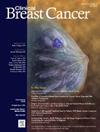Trends and Regional Differences for Fertility Preservation Procedures in Women With Breast Cancer
IF 2.9
3区 医学
Q2 ONCOLOGY
引用次数: 0
Abstract
Introduction
Breast cancer is the most common malignancy in women of reproductive age and chemotherapy protocols impair fertility, frequently necessitating fertility preservation (FP) referral. Embryo, oocyte, or ovarian tissue cryopreservation are established FP modalities in women with breast cancer but there are few data on their uptake over time. In this study our aim was to determine the regional time trends and utility differences for fertility preservation methods of reproductive tissue cryopreservation.
Methods
This multicenter study included 1623 women diagnosed with breast cancer from 7 tertiary centers in 6 countries (Brazil, Italy, Scotland, South Korea, Turkey, USA). Participant centers provided the details of FP cryopreservation approaches broken down annually from 2012 to 2021. Women with newly diagnosed breast cancer, aged 18-45 years who were referred for FP at participating centers and had normal ovarian function at the time were included.
Results
We found a mean increase of 7% per year (P = .002, adjusting for centers) in the number of women referred for FP. Of those who were referred (n = 1623), a mean 38.7% underwent FP (n = 629), with a range of 12% in South Korea) to 95% in Brazil. The number of women undergoing ovarian stimulation for FP continually increased until 2021, with oocyte cryopreservation being the most common procedure throughout the study period (P = .014 for time trend). The proportion of random start ovarian stimulation cycles increased each year from 58.3% in 2012 to 86.8% in 2021, (P = .005 for time trend, and P = .04 for 2012 vs. 2021).
Conclusions
The utility of FP has steadily increased for young women with breast cancer over the last decade, although regional differences significantly influence FP practices. The findings of our study could have value for policy making in FP care for young women with breast cancer at the local, regional, or global level.
乳腺癌妇女生育力保存程序的趋势和地区差异。
导言:乳腺癌是育龄妇女最常见的恶性肿瘤,化疗方案会损害生育能力,因此经常需要转诊进行生育力保存(FP)。胚胎、卵母细胞或卵巢组织冷冻保存是治疗乳腺癌妇女的成熟生育力保存方式,但有关其长期使用情况的数据却很少。在这项研究中,我们的目的是确定生殖组织冷冻的生育力保存方法的地区时间趋势和效用差异:这项多中心研究纳入了来自 6 个国家(巴西、意大利、苏格兰、韩国、土耳其和美国)7 个三级医疗中心的 1623 名确诊为乳腺癌的女性。参与研究的中心提供了从 2012 年到 2021 年每年的 FP 冷冻方法的详细信息。研究对象包括新诊断为乳腺癌的女性,年龄在18-45岁之间,在参与中心接受FP治疗,且当时卵巢功能正常:我们发现,转诊接受 FP 治疗的女性人数平均每年增加 7%(P = .002,根据中心进行调整)。在转诊的妇女中(n = 1623),平均有 38.7% 接受了 FP(n = 629),范围从韩国的 12% 到巴西的 95%。直到 2021 年,接受卵巢刺激进行 FP 的女性人数持续增加,在整个研究期间,卵母细胞冷冻保存是最常见的程序(时间趋势 P = .014)。随机启动卵巢刺激周期的比例逐年增加,从2012年的58.3%增至2021年的86.8%(时间趋势的P = .005,2012年与2021年的P = .04):结论:过去十年来,FP对年轻乳腺癌女性患者的实用性稳步提高,但地区差异对FP的使用有很大影响。我们的研究结果对制定地方、地区或全球层面的年轻女性乳腺癌患者 FP 护理政策具有重要价值。
本文章由计算机程序翻译,如有差异,请以英文原文为准。
求助全文
约1分钟内获得全文
求助全文
来源期刊

Clinical breast cancer
医学-肿瘤学
CiteScore
5.40
自引率
3.20%
发文量
174
审稿时长
48 days
期刊介绍:
Clinical Breast Cancer is a peer-reviewed bimonthly journal that publishes original articles describing various aspects of clinical and translational research of breast cancer. Clinical Breast Cancer is devoted to articles on detection, diagnosis, prevention, and treatment of breast cancer. The main emphasis is on recent scientific developments in all areas related to breast cancer. Specific areas of interest include clinical research reports from various therapeutic modalities, cancer genetics, drug sensitivity and resistance, novel imaging, tumor genomics, biomarkers, and chemoprevention strategies.
 求助内容:
求助内容: 应助结果提醒方式:
应助结果提醒方式:


